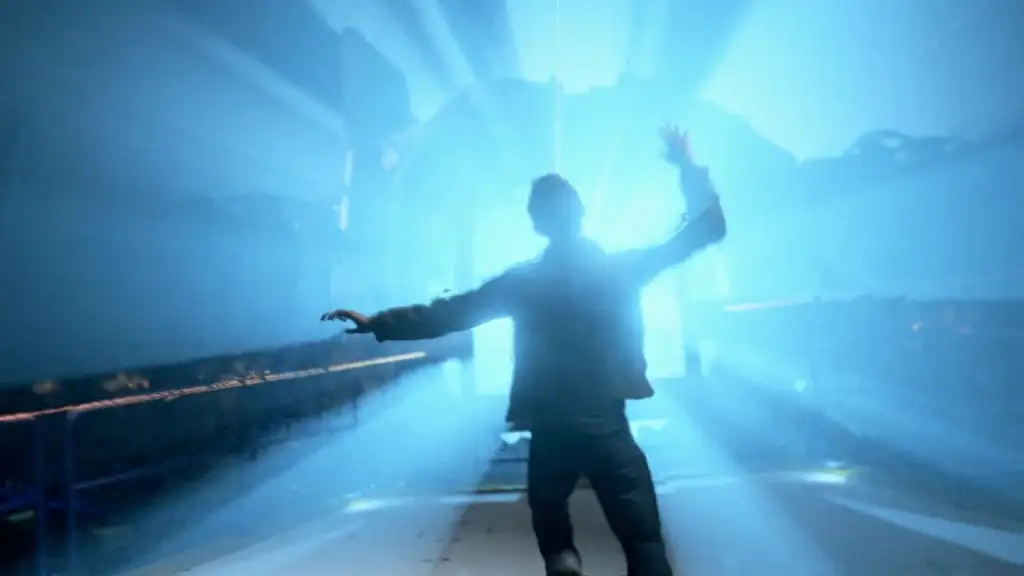Quantum Break did not have the most auspicious of PC launches. For starters, it was limited to the commercial limbo that is the Windows Store; for another thing, it was apparently broken beyond all recognition with absurdly low framerates, ridiculous input lag, and such a lack of polish it could probably be described as something that looked like it had been anti-polished. (Or so I’ve heard. For some reason, we didn’t get code.)
Fittingly for a game all about time, though, the Remedy-developed shooter/TV show hybrid is getting a second chance through the magic of a Steam release. Have the extra few months helped Quantum Break reboot its chances at a second first impression? Let’s find out. After freeing up nearly 70GB of space, that is.
I’ll point out, again, that we did not receive code for the initial Windows Store release. Whether that’s because it was reportedly a clusterfuck of staggering proportions, or if it’s just because the Windows Store doesn’t make giving out code easy (I don’t believe we’ve ever received code for a game via that service), I don’t know. Either way, I didn’t play the initial release, so I can’t directly compare the two.

No, there doesn’t appear to be a way to turn off motion blur, unless it’s part of “Effects Quality.”
First up, the options. I’m not going to bother showing the Gameplay, Controls, and Audio settings because they’re largely what you’d expect – mouse sensitivity, rebindable keys, volume settings – although I will note a few specific ones that I rather like. For starters, there’s the “Disable copyrighted music” setting, so that your stream or YouTube video doesn’t get flagged or silenced for copyright. I’ll also quickly add that the controls do indeed properly support mouse and keyboard, with things like “the mouse wheel can be used to swap weapons” fully present and correct.
Display is likely what you’re probably more interested in, though:
It defaulted to Medium presets, although I suspect that’s by default rather than by any automatic benchmarking. The settings themselves mostly range from Medium to Ultra, with Low apparently a dirty word for this release. Oddly, Ultra doesn’t actually set everything to maximum – it sets Texture Resolution to maximum, but bits and pieces like shadow resolution are left on High rather than Ultra. A mild oddity.
In any case it’s a good set of tweakables, and they’re (mostly) neatly explained courtesy of tooltips on the right. The 30FPS lock is thankfully disabled by default, and the rest offer everything from texture quality to SSAO to shadow filtering, as well as more generic options like “subtitles”. If there’s one mild annoyance it’s that Anti-Aliasing is basically stuck with “on” and “off” rather than FXAA, MSAA and the like, but this appears to be a limitation of the engine that we’ll get to shortly. Also, no option to turn off the bloody motion blur. I sigh.
From what I’ve dug up, some of this has been stuff that was added after the initial launch. Back when Quantum Break got its ill-fated start on the Windows Store, there was no option to turn off the film grain, and it looks like there wasn’t any sort of V-sync option either. Hell, apparently, there wasn’t even an option to go back to the main menu from within the game. It’s fair to say that things have improved since then.
For what it’s worth, here are some comparison screenshots with everything shunted up to the absolute maximum, and everything dropped to the bare minimum. There is one exception, which is the upscaling: it’s turned on in the Ultra, but turned off in Low, because I hadn’t quite thought that through yet.
I’m going to guess you can tell which one is Ultra and which one is Low. (Also, that white marker on the board is part of the UI; it’s meant to be there.)
The upscaling option is the one I’ve been dreading talking about. Here’s what Remedy had to say about the render technique and resolution back in April.
The Windows 10 version of Quantum Break uses the same reconstruction method as on Xbox One. If your resolution is set to 1080p, the game temporally reconstructs the image (except UI) from four 720p buffers rendered with 4xMSAA, just like on Xbox One. Engine assigns input geometry samples from 4xMSAA rendering into shaded clusters in order to maximize covered geometry while keeping the performance on acceptable level by reducing expensive shaded samples. When you change the resolution, the buffers used to construct the image are always 2/3rds of the set resolution, i.e. in 2560×1440 they would be 1706×960.
I’m not even going to pretend like I fully understand that, but from what I can gather, it basically renders the game four times in 720p and then composites them together to create a 1080p image… which sounds rather more complicated and intensive than just rendering the game in 1080p, but then, there’s a reason why I don’t write game engines. I suspect this means you won’t be running Quantum Break in anything about 1920×1080, though.
Now, upscaling. I actually wrote an incredibly lengthy section on this, complete with 6 different comparison screenshots, and then discovered I was working on a false assumption and aaaargh so now I’m rewriting it.
I have no idea why upscaling isn’t disabled by default in Ultra, at least, but it may be some sort of artistic choice. Here are four screenshots showing upscaling and film grain toggled on and off:

Upscaling off, film grain off, and even protagonist Jack is starting to look a bit pissed off by the sun at this point.
You’ll probably need to Click For Bigger to see the differences, but they’re pretty noticeable in the game itself. While film grain has a pretty negligible impact on the visuals to my eyes, upscaling basically smears everything with Vaseline. With upscaling turned off, the textures are a fair bit sharper; with upscaling on, things are just over the edge of blurriness that I start to wonder if I finally need glasses.
This is not as bad as I first thought, where upscaling appeared to have a weird effect of screwing with the shadows. This turned out to be because the game takes a fairly lengthy amount of time to reload the shadows after you change the upscaling setting.
In any case, turning upscaling off definitely seems to be the way to go, which makes me wonder why it’s always turned on by default. Best guess is that it’s either an artistic choice (as with the film grain), or that it’s simply down to performance – but I didn’t notice any significant performance differences between the two. Aside from a few weird issues like that, and the fact that the lighting effects are a little excessive and off-putting when everything isn’t going all timey-wimey, this actually appears to have been ported to the PC about as best as possible.
Considering the problems Quantum Break had on its Windows Store launch, it maybe seems a bit odd that I said “ported to the PC about as best as possible”, but this Steam release is eminently playable.
I’m working on an i7-3820 with 16GB RAM and a GeForce GTX 970, and in Act One the game pretty much flies along at 60FPS, on Ultra presets, with only occasional framerate hiccups – usually when loading into a new area. The framerate never dropped significantly, and never for very long. (I have a suspicion that a few cutscenes are forced to 30FPS, as that’s what the Xbox One version was locked at, but I can’t say for sure right now.) Manually bumping everything up to Ultra lowered the framerate noticeably, but I’m pretty happy with just running the game on “mostly high” settings.
This is admittedly a sample size of one, so it’s entirely possible people will still find the game running at four seconds per frame. Still, it works alright for me, which is honestly better than I expected. I’ll also note that I’m actually running on Windows 10, so I have no idea how this new Windows 7-compatible DirectX 11 version functions on an actual Windows 7 machine. This may also prove to be a major factor.

This basically appears to be the plot of the game in a nutshell. Or an eggshell. Sort of like Chuckie Egg, but with more swearing and abuse of immutable physical laws.
The only major issue I have, barring some of the aforementioned graphical stuff, is the frighteningly low FOV. There’s no way to change this in game, and considering the cinematic nature of the entire product, I’m guessing this is another very deliberate thing (and that changing the FOV would screw up both some of the in-engine cutscene stuff, and quite possibly the upscaled rendering). Nonetheless, it’s definitely something to be cautious of: you’ll be staring at the back of the protagonist’s neck quite a lot.
As for Quantum Break itself, I’m steadfastly undecided. It’s a very weird cross-media experiment – you play the game, mostly as a cover shooter with magic time-bending powers, but every act is book-ended by a 30-minute live-action “episode” covering other events in the game’s world. These episodes are purportedly changed by the actions you take within the game itself. I can’t speak to how deep these differences go, but one seemingly had a major difference, while another – examining an equation on a whiteboard – led to someone saying, at the start of a scene, “Hey, someone solved the equation on the whiteboard.” So, uh… I don’t know quite how that’ll shake out.
Still, it’s nice having live-action stuff with decent actors. Aiden Gillen (Littlefinger) seems to find the scenery delicious judging by how much he’s chewing it, and – in the first episode at least – everyone largely plays their roles well. Also, Lance Reddick! I’m always happy to see Lance Reddick, especially when he’s being disturbing and evil. The heavy mocap means that most of the in-game animations for these characters are pretty good, although there is a serious risk of them tripping and falling into the uncanny valley. A risk that, uh, actually happens quite a lot. It’s not constant, but there’s still something a little eerie and off-putting about some of the digitised people.
The gameplay itself hasn’t wowed me yet, but then I suspect I’m only really getting out of tutorial land. Unsurprisingly for a game from Remedy, it feels quite a lot like Max Payne with some elements of F.E.A.R. thrown in for good measure. Shooting doesn’t feel particularly effective, with enemies taking quite a lot of shots to kill and aiming feeling just a little off, but playing with the time powers is predictably entertaining.
So yes, you’re crashing down doors that inevitably lead to rooms full of baddies who need to be shot in their faces until they’ve stopped being bad, and occasionally jumping around to find collectibles in order to upgrade your time wizardry. It’s very linear and almost entirely inorganic, and thus far it’s a bit predictable and a bit unimpressive, with a few really irritating clipping issues… but then, I’ve barely started. It may improve drastically.
From my experience, at least, Quantum Break appears to finally have a good PC version. It’s certainly not perfect, but I suspect issues like the FOV are hard-baked into the game, so it’s possibly not fair to have expected that to change. Don’t get me wrong: these things are definitely problematic, but I don’t know that I’d have expected anything better after the disastrous initial launch. The fact that it runs at 60FPS, has a fair few tweakables, doesn’t suffer horrific slowdown, and has natural-feeling mouse and keyboard controls is enough for me to say that – while not a built-from-the-ground-up PC version – this appears to be a perfectly solid port that’s probably a step or two above a lot of the usual console-to-PC fare.
















